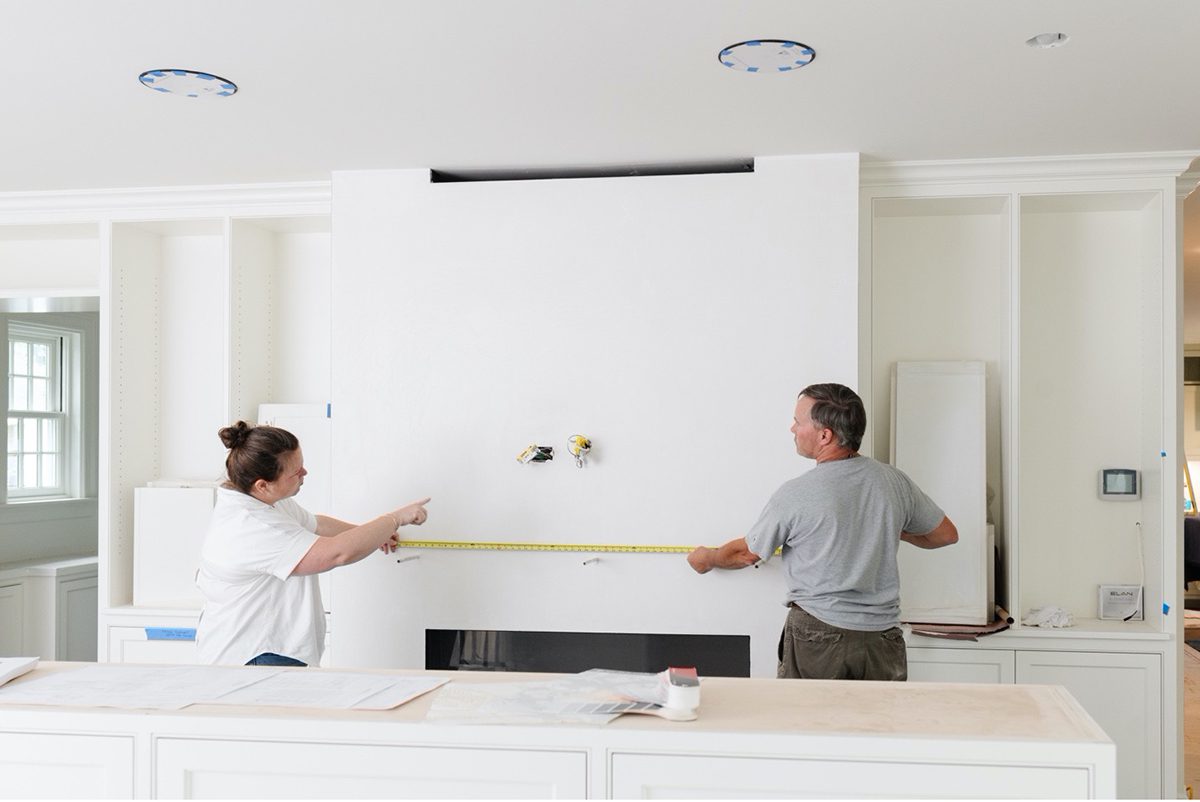Interior Designer vs. Construction Supervisor: What’s the Difference?
August 22, 2022
Involving an interior designer in the entire design and build process ensures the entire home looks and functions seamlessly.
Text by Kristin Amico

There are many benefits to using an interior designer. They translate your vision into reality and create spaces that are equally beautiful and functional, and they do so in a way that reflects how you and your family live. What you may not know is that involving your interior designer in the entire design and build process—from the first sketch to weekly walk-throughs and final reveal —ensures the entire home looks and functions seamlessly.
While construction supervisors oversee the development of projects at a worksite, managing crews, observing health and safety codes, and completing work on time, it’s the interior designer that ensures delivery of the original design. And when problems arise, they are there to troubleshoot.
Examples of this include homeowners requesting last-minute additions to their design after construction has started or discovering a hidden obstacle after removing a wall during a renovation. It happens regularly. So, it’s important for the interior designer to regroup with the builder and architect on-site to resolve issues in real-time. Emily Pinney, founder of Pinney Designs, a full-service interior design firm located in Metro Boston, explains why it’s important to have a designer work alongside the full project team, and why every designer should make regular site visits.

1. Interior Design Starts at the Conceptual Phase – Not Construction
Whether it’s the interior or exterior, an interior designer’s role from design to build is integral. Before mistaking that an interior designer’s work only focuses on the finishing touches, it’s important to understand that electrical, plumbing and engineering must support your overall design. Avoid extra costs due to time delays, installation, and repairs to make corrections for your design after the home has been built or renovated. For those undertaking larger projects that require a builder, architect, and interior designer, Pinney advises assembling the whole team before the project kickoff. “The interior designer understands the big picture and the small details. When brought in at the start of a project, they will work closely with the other contractors to provide the necessary design input, ensuring that design wishes are factored into building plans,” notes Pinney. A danger in bringing each contractor onto the project at different phases is that the design and build team may have distinct ideas for how to execute specific details. For example, if a builder adds ductwork in key spots in the wall or ceiling, that may later impact a designer’s ability to place lighting, artwork, or built-in cabinetry. “Having everyone sit down in a room at the kickoff lets designers and builders raise concerns or offer alternative suggestions before problems arise,” adds Pinney.

2. Site Visits Tackle Issues in Real-Time while Avoiding Delays
As important as it is to have your team working as a cohesive unit before any walls are constructed or torn down, it’s just as important to have them working as a team throughout the project. Pre-construction planning helps avoid big headaches or cost overruns. Having your interior designer regularly attend meetings and site visits during the construction phase helps ensure the design is executed according to plan. “Home renovations and new building projects can be complex. Items that initially look great on paper may need small adjustments during implementation. Having a designer make regular site visits ensures that every detail is executed in a way that lives up to the design goal,” says Pinney. Small construction changes often need to be made mid-process, especially with older homes. If your designer is regularly briefed, they can work with the contractor on-site to make any needed modifications. Additionally, Pinney points to detailed design projects like tile installation where communication gaps can happen, especially with complex designs. A designer who regularly checks in with tradespeople helps eliminate those issues.
3. An Interior Architecture Specialist is your Best Advocate on the Jobsite
Design-and-build projects are time-consuming. Homeowners may not be available to attend every walk-through or update meeting. Instead, Pinney suggests working with the interior designer to help coordinate meetings with the team if the homeowners are unable to attend. “We often take notes for our clients during these meetings and confirm that all the selections and other details are carried out in an agreed-upon way. We can then communicate updates and answer questions, so homeowners don’t need to have multiple conversations with multiple contractors,” says Pinney.

4. Surprises are fun but not when they pop up in your budget
Having the entire team work together from the start is one way to prevent big cost overruns or surprise expenses. Additionally, when the designer is involved in regular site visits, they’ll be able to provide feedback immediately and help prevent small design or build issues from becoming big ones. Strong teamwork will also keep scope creep in check, so the client understands how plan changes affect the overall budget.

” If a problem or obstacle arises during construction that affects the final interior design, the designer manages the necessary changes to ensure the results reflect the client’s original vision,” explains Pinney.

Pinney Designs, pinneydesigns.com
Share
![NEH-Logo_Black[1] NEH-Logo_Black[1]](https://b2915716.smushcdn.com/2915716/wp-content/uploads/2022/08/NEH-Logo_Black1-300x162.jpg?lossy=1&strip=1&webp=1)







You must be logged in to post a comment.